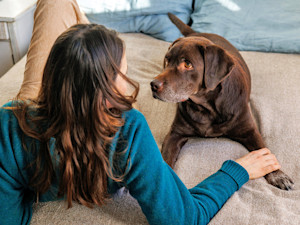Dogs Are Able to Combine Words Using Speech Buttons, New Study Finds
They can tell you they want to go “out” and “play,” stat.

Share Article
By now, most of us have seen videos of pups pressing on buttons to communicate in English, whether they’re stomping on “out” to request a walk or, in the case of the famous Bunny,opens in new tab communicating their deepest emotionsopens in new tab or making small talk about the weather.opens in new tab
If social media comments are any indication, most people are delighted to see the “speech buttons” — buttons pre-programmed to announce words aloud when pressed — in use, but some are a little more suspicious, chalking the behavior up to chance or prompting. Now, there’s some compelling news for skeptics: A new studyopens in new tab published in Scientific Reports found that dogs can combine words using speech buttons in ways that surpass imitation or random chance.
Over the course of 21 months, researchers collected data from the FluentPet mobile app, where pet parents logged their pets’ button use, as well as their own button use. In the end, researchers analyzed 194,901 soundboard interactions by 152 dogs. Nearly thirty percent of the soundboard interactions — 56,676 presses — were multi-button combinations.
Using statistical analysis, they found that combinations pressed by dogs were not random, and certain combinations happened more often than expected by chance; for example, words like “outside” and “potty,” as well as “food” and “water,” were frequently combined, reported Phys.orgopens in new tab. “Our results suggest that owner-trained dogs can press buttons on their soundboards in a non-accidental and non-random fashion,” Amalia P. M. Bastos, the study’s lead author, wrote.
How much do you spend on your pet per year?

They also found that dogs were not simply imitating their humans’ behavior when they pressed buttons, because many of the most commonly pressed buttons by humans different from the most commonly pressed buttons by dogs. “We found that there was only a minimal association between the identity of individual buttons pressed by dogs and the buttons pressed by their owner,” the study’s lead author Bastos wrote.
It’s still unclear exactly how far dogs’ understanding of speech buttons goes — and how many dogs truly have a talent for language. Some so-called Gifted Word Learneropens in new tab dogs can learn dozens of words, while others have more limited vocabularies. Researchers point out that there is variation between the study subjects, with some pups being more consistent with combinations, while others approach randomness. So, while there’s evidence that dogs can intentionally combine words, that might not mean that any pup is the next Shakespeare.
Regardless, Federico Rossano, a senior researcher on the paper, is excited about what the results say about the potential of dogs to communicate with humans. “Soundboards could allow for more precise communication,” Rossano told Phys.orgopens in new tab. “Instead of barking or scratching at the door, a dog may be able to tell you exactly what it wants, even combining concepts like ‘outside’ and ‘park’ or ‘beach.’ This could improve companionship and strengthen the bond between dogs and their owners.”

Sio Hornbuckle
Sio Hornbuckle is the Assistant Editor at Kinship, where they frequently write for the site. As a writer, they specialize in pet news, animal science, and pop culture. They live in New York City with their cat, Toni Collette.
Related articles
![Woman teaching her dog how to use speech buttons.]()
Dogs Really Do Understand Speech Buttons, New Study Finds
Those viral Tiktok videos may not be all smoke and mirrors.
![]()
What Are Dog Communication Buttons? And How to Use Them
Cognitive Science professor Dr. Federico Rossano on how Bunny, TikTok’s “talking” dog, is sparking change in how we communicate with our pets.
![Woman in bed with her dog at home.]()
Dogs Understand Us Better When We Speak Slowly, Study Finds
If you can’t get your pup’s attention, try slowing down.
![White cat with black head spots standing in front of verbal buttons on the living room floor]()
Speech Buttons Aren’t Just for Dogs — Cats Are Chiming In, Too
Cat behaviorist Kristiina Wilson and her viral cat, Steve, are successfully communicating with speech buttons.
![Woman looking into her Beagle dog's eyes.]()
Dog and Human Brains Sync When They Stare Into Each Other’s Eyes, New Study Finds
You and your pup are on the same wavelength—seriously.
![Woman watching tv with her small dog at home.]()
Many People Would Rather Watch Movies With Their Dogs Than Their Partners, Poll Finds
Unlike your beau, your pup won’t interrupt the film to ask questions.





